Table of Contents[Hide][Show]
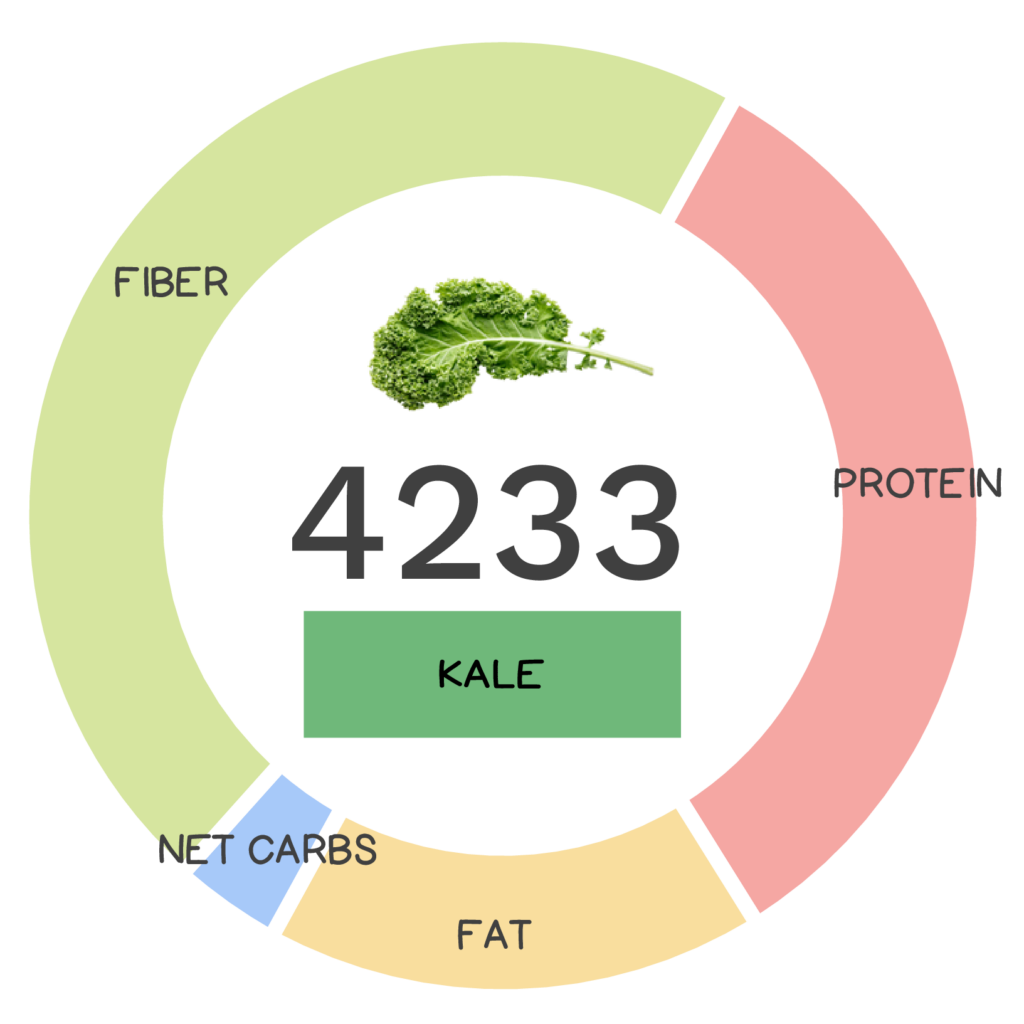
Kale is one of those “superfoods” that’s been tremendously hyped in recent years, and its reputation is well deserved! This cruciferous vegetable is a member of the Brassicaceae family of plants that includes broccoli, Brussels sprouts, cabbage, cauliflower, collard greens, and kohlrabi. All members of this family originally descended from wild cabbage with the original species evolving over thousands of years into cultivars with different characteristics enjoyed as numerous common veggies today. For instance, cultivars with large compact heads became cabbage, large tender flowering heads for cauliflower, thick stems with edible immature flower buds for broccoli, and large leaves for kale! In fact, selection of plants with enlarged leaves led to the development of kale in 5th century BC and the botanical name of kale (Brassica oleracea variety acephala) literally means ‘cabbage of the vegetable garden without a head’!
All members of the cruciferous vegetable family originally descended from wild cabbage.
Even though its spike in popularity might seem recent, it’s actually been incredibly popular throughout the ages; in fact, kale originated in the eastern Mediterranean and has been cultivated as food since at least 2,000 BC. It was one of the most common green vegetables in Europe until the end of the Middle Ages (in part because it grows easily in slightly chilly environments and can tolerate the frosts of early winter). In fact, cool weather and the chill of frost improves the flavor of kale, helping to bring out its sweetness. During World War II, the cultivation of kale in home gardens was encouraged as it was easy to grow and provided important nutrients missing from diets because of rationing. Interestingly, in Scotland, kale is such a staple of the traditional diet that the word in some Scots dialects is synonymous with the word for food!
Kale originated in the eastern Mediterranean and has been cultivated as food since at least 2,000 BC.
In recent years, the popularity of kale has skyrocketed in North America thanks to its nutritional value (as far as superfoods go, it’s fairly cheap and easily found). As such, today there are many varieties to choose from beyond the common curly green kale we all know and love. This veggie comes in a wide range of textures, including frilled, crinkly, flat or bumpy leaves ranging in colors from numerous shades of green to dark red or purple! Many varieties are even grown for ornamental purposes and are finding use in ornamental bouquets. Let’s just say this crucifer is “kale’n” it!
Learn What Foods to *ADD* to Your Diet
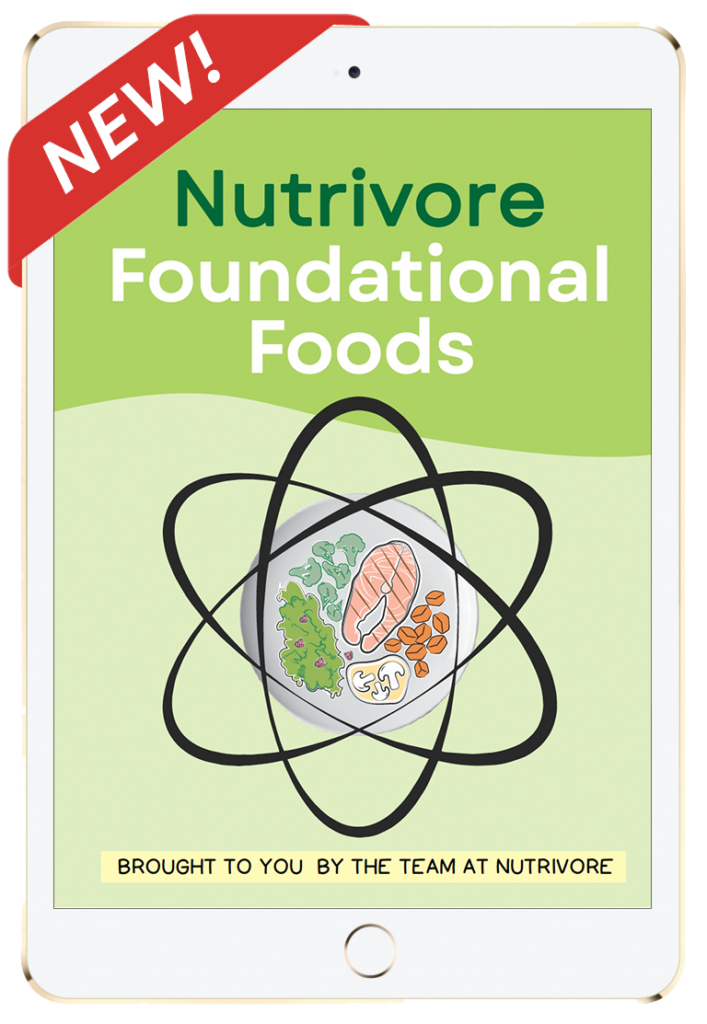
Nutrivore Foundational Foods
Learn what makes the 12 Nutrivore foundational food families nutritionally unique, their health benefits, which options are the most nutrient dense, how much of them to eat, plus various fun facts, practical pointers, and busting of common myths.
This very helpful resource will introduce you to new foods and expand your nutrition knowledge, making food choices easier!
Buy now for instant digital access.

Nutrivore Score for Kale – 4233
Kale has a Nutrivore Score of 4233, making it one of the most nutrient-dense foods on the planet! Plus, it is a low-carb and low-calorie-density food; amazingly the calorie count of kale is just 9 calories per cup!
Per serving, kale is a best source (>50% daily value) of carotenoids, glucosinolates, vitamin B7 (biotin), vitamin C and vitamin K; is an excellent source (20-50% daily value) of manganese and polyphenols; and is a good source (10-20% daily value) of alpha-linolenic acid (ALA), calcium, vitamin A, and vitamin B2 (riboflavin).
Ditch Diets. Embrace Nutrients. Start with this FREE Guide.
Sign up for the free Nutrivore Newsletter, your weekly, science-backed guide to improving health through nutrient-rich foods — without dieting harder —and get the Beginner’s Guide to Nutrivore delivered straight to your inbox!

Kale Nutrition Facts
One serving of kale is standardized to 2 cups of kale, or about 50 grams (1.8 ounces). When you cook kale, it reduces in volume by approximately 80% which means: 5.5 cups raw kale is roughly equivalent to 1 cup boiled kale.
Kale Nutrition Facts Per Serving
| Kale, raw | Nutrivore Score: 4233 | Nutrient Density: Super! |
|---|---|---|
| Serving Size: 2 cups (50 grams) | Protein: 1.5 grams | Net Carbohydrates: 0.2 grams |
| Calories: 19 | Total Fat: 0.7 grams | Dietary Fiber: 2.1 grams |
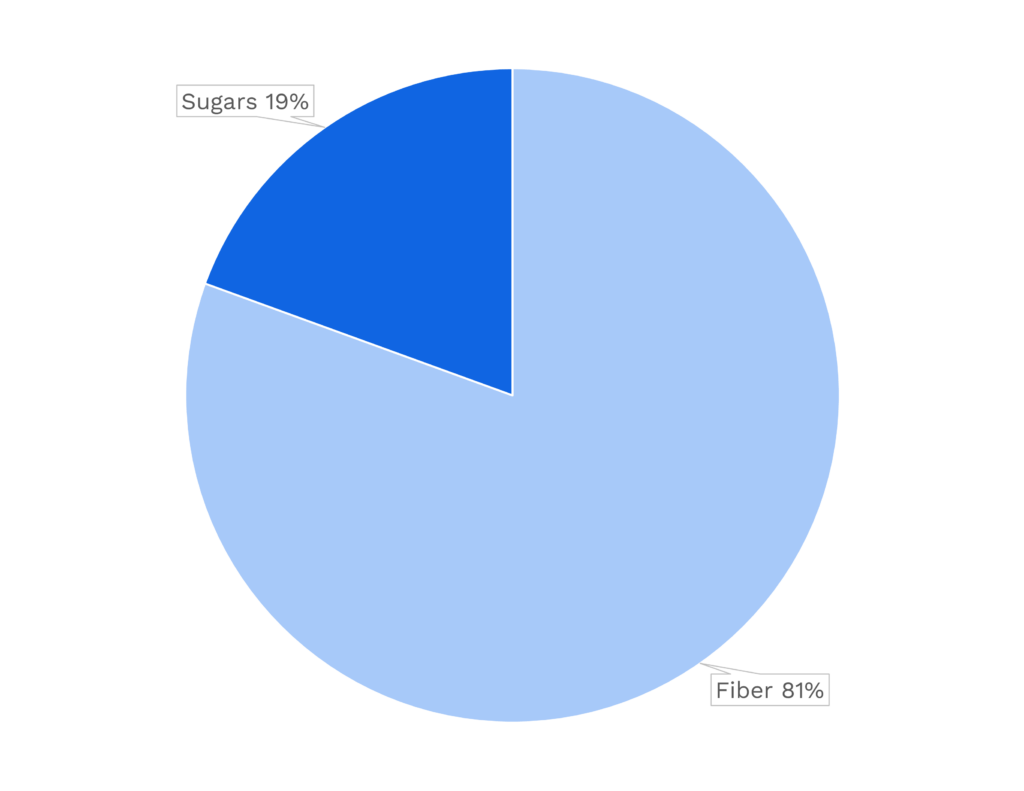
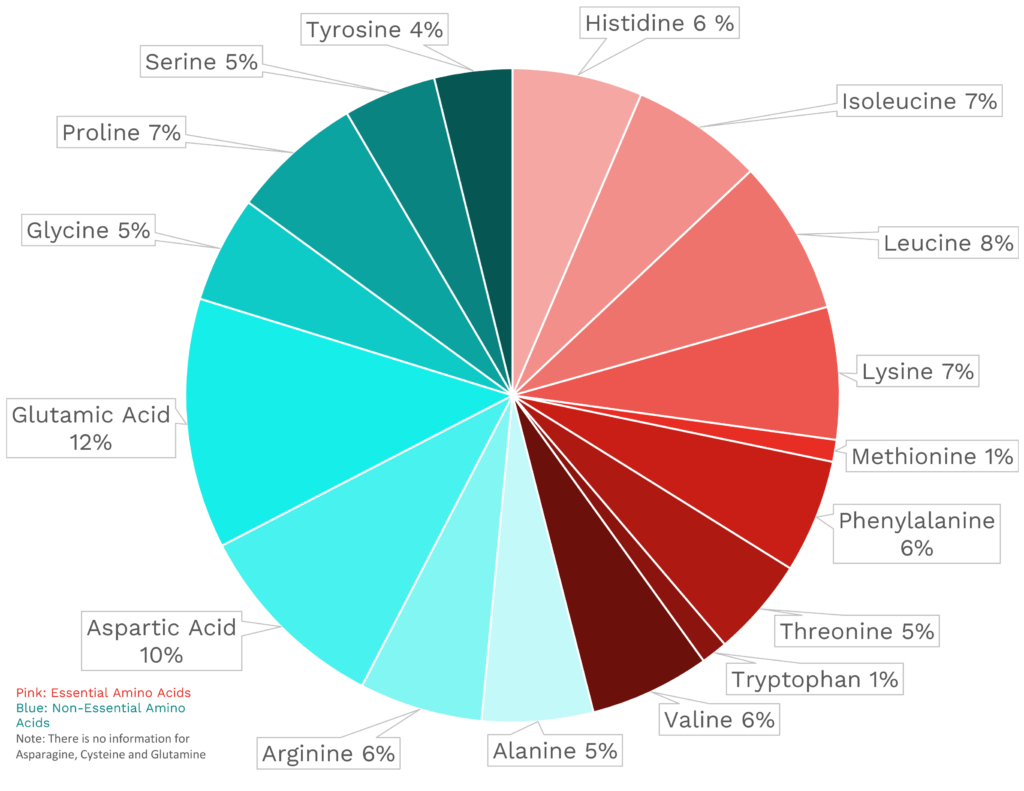
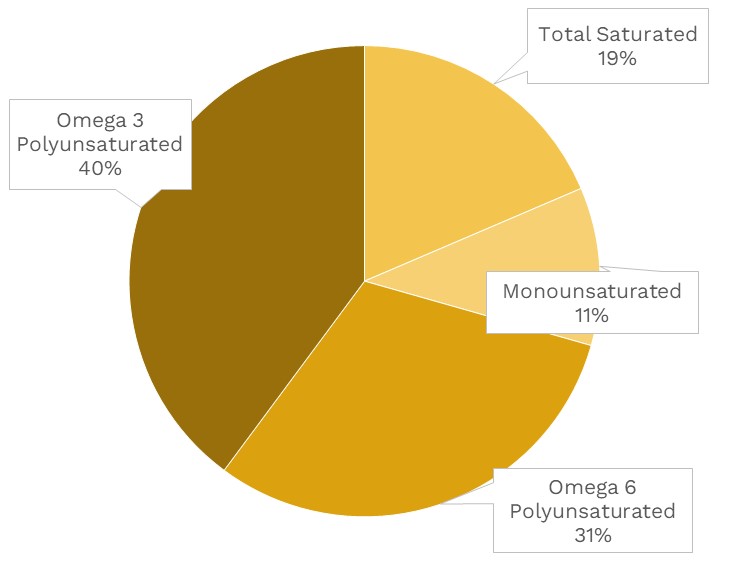
| VITAMINS | ||
|---|---|---|
| Vitamin A | 120.5 μg RAE | 13% DV |
| Vitamin B1 (Thiamin) | 56.5 μg | 5% DV |
| Vitamin B2 (Riboflavin) | 173.5 μg | 13% DV |
| Vitamin B3 (Niacin) | 0.6 mg | 4% DV |
| Vitamin B5 (Pantothenic Acid) | 0.2 mg | 4% DV |
| Vitamin B6 (Pyridoxine) | 73.5 μg | 4% DV |
| Vitamin B7 (Biotin) | 18.0 μg | 60% DV |
| Vitamin B9 (Folate) | 31.0 μg | 8% DV |
| Vitamin B12 (Cobalamin) | 0.0 μg | 0% DV |
| Vitamin C | 49.0 mg | 54% DV |
| Vitamin D (D2 + D3) | 0.0 μg | 0% DV |
| Vitamin E | 0.4 mg | 3% DV |
| Vitamin K | 194.8 μg | 162% DV |
| Choline | 0.3 mg | 0% DV |
| Myo-Inositol | ~ | ~ |
| CoQ10 | ~ | ~ |
| FUNCTIONAL FATS | ||
|---|---|---|
| MUFA | 0.1 g | 0% DV |
| ALA | 189.0 mg | 12% DV |
| EPA + DHA | 0.0 mg | 0% DV |
| CLA | ~ | ~ |
| Linoleic Acid | 0.1 g | 1% DV |
| MCT’s | 0.0 g | ~ |
| MINERALS | ||
|---|---|---|
| Calcium | 127.0 mg | 10% DV |
| Copper | 26.5 μg | 3% DV |
| Iodine | ~ | ~ |
| Iron | 0.8 mg | 4% DV |
| Magnesium | 16.5 mg | 4% DV |
| Manganese | 460.0 μg | 20% DV |
| Phosphorus | 27.5 mg | 2% DV |
| Potassium | 174.0 mg | 4% DV |
| Selenium | 0.5 μg | 1% DV |
| Sodium | 26.5 mg | 1% DV |
| Zinc | 0.2 mg | 2% DV |
| PHYTONUTRIENTS | ||
|---|---|---|
| Carotenoids | 4580.5 μg | ~ |
| Polyphenols | 177.5 mg | ~ |
| Phytosterols | 4.4 mg | ~ |
| Glucosinolates | 158.6 mg | ~ |
| Thiosulfinates | ~ | ~ |
| Betalains | ~ | ~ |
| AMINO ACIDS & PEPTIDES | ||
|---|---|---|
| Taurine | ~ | ~ |
| Ergothioneine | 0.0 mg | ~ |
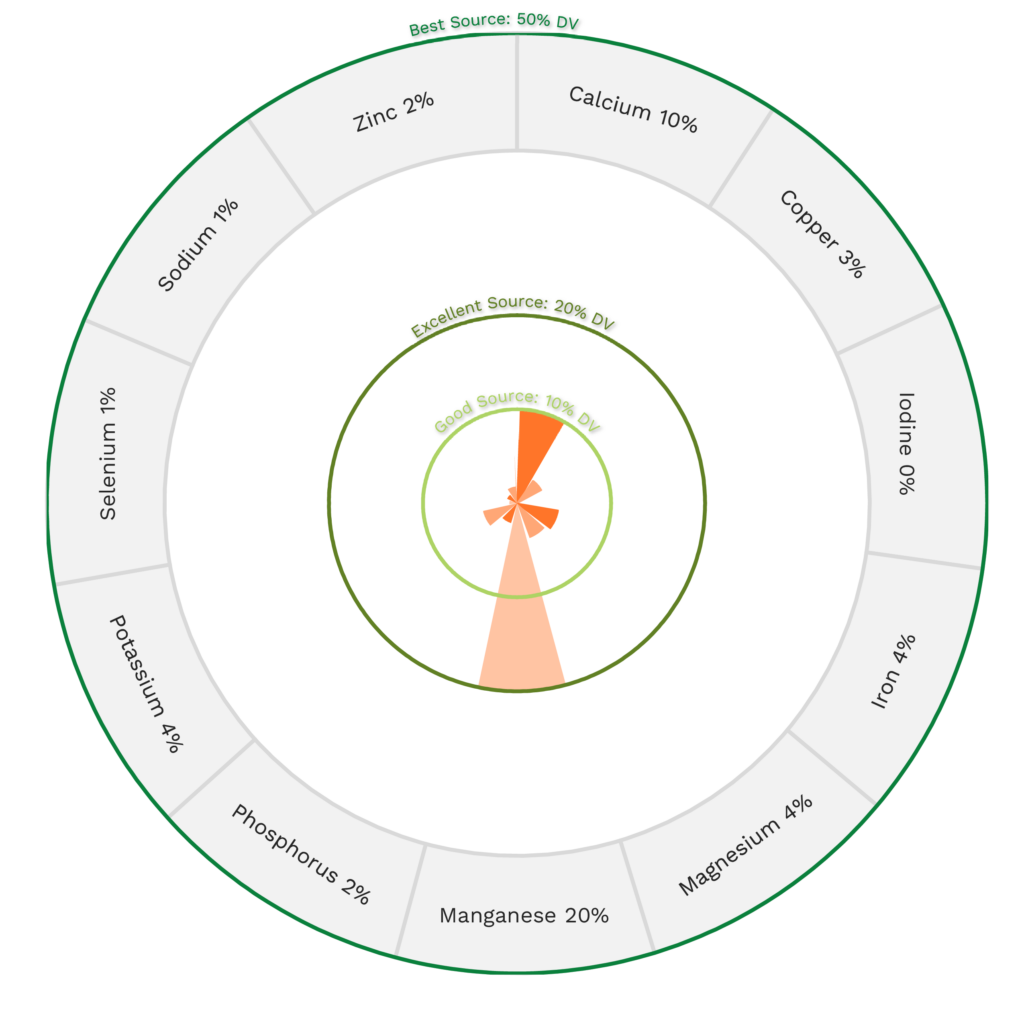
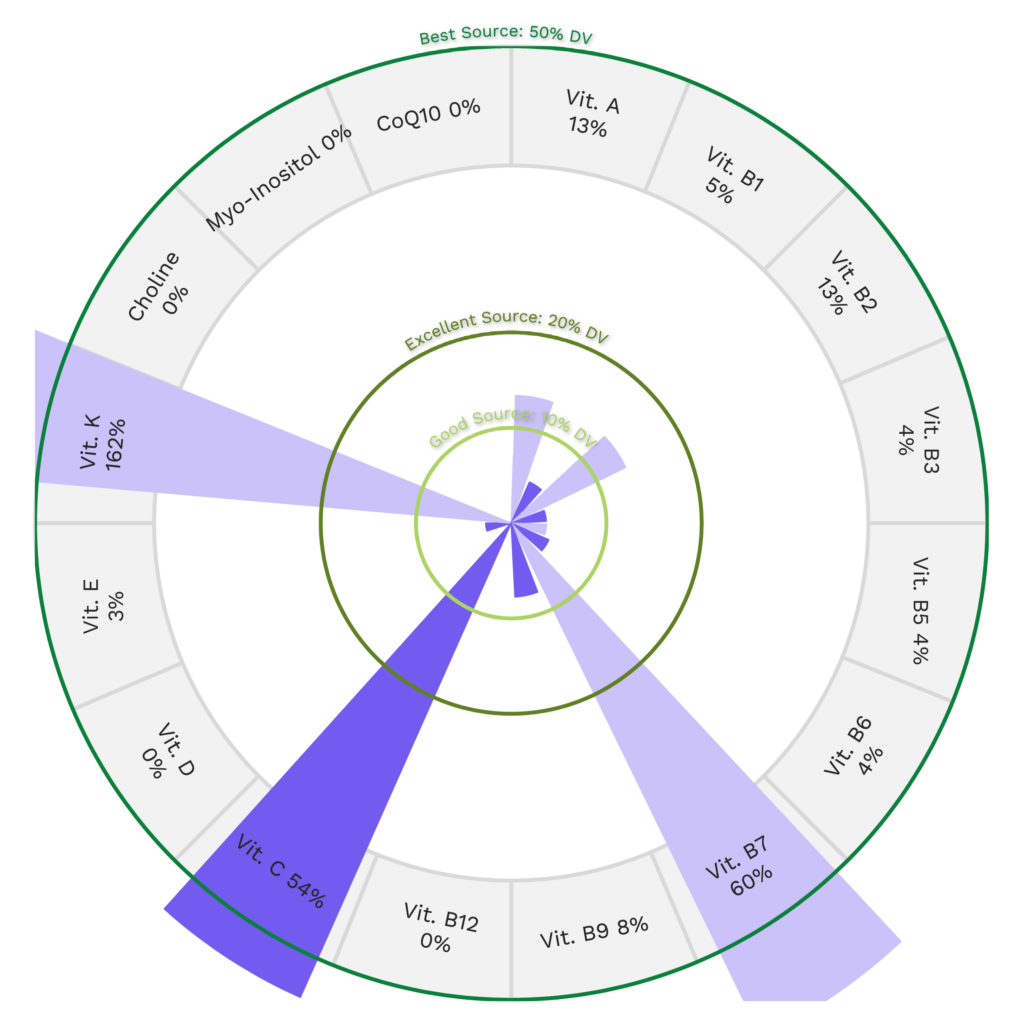
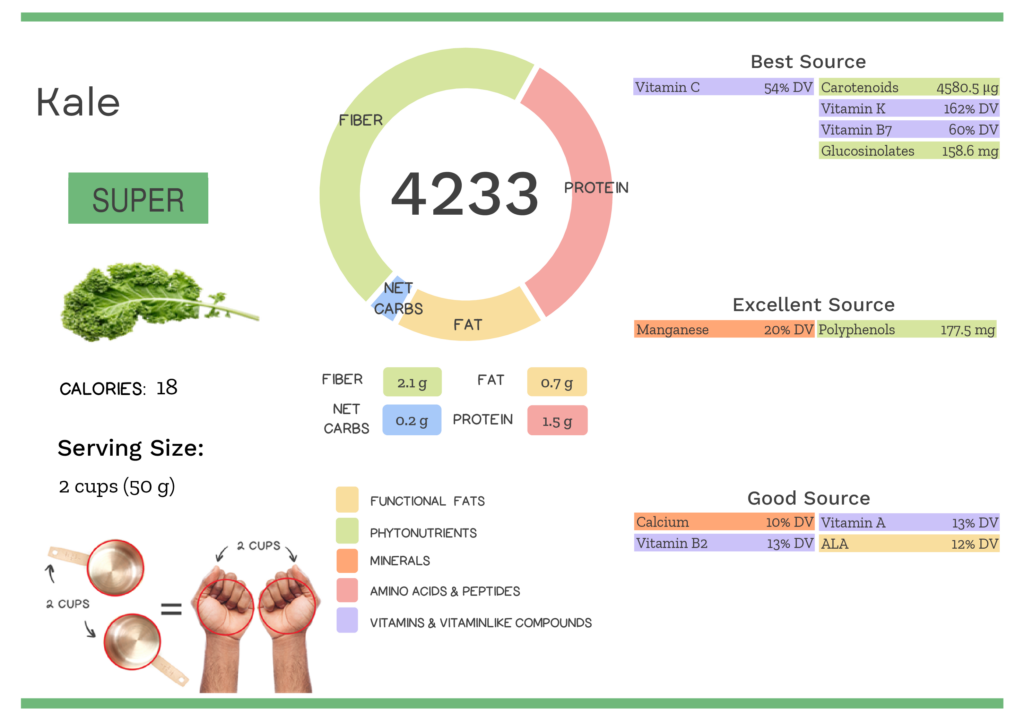
Kale Nutrition Varies With Cooking and Processing
The Nutrivore Score for kale varies depending on method of preparation and processing. For instance, frozen kale is a convenient option available year-round at your local grocery store.
| NUTRIVORE SCORE | |
|---|---|
| Kale, cooked, boiled, drained, with salt | 3644 |
| Kale, cooked, boiled, drained, without salt | 3968 |
| Kale, frozen, cooked, boiled, drained, with salt | 3945 |
| Kale, frozen, cooked, boiled, drained, without salt | 3945 |
| Kale, frozen, unprepared | 4070 |
| Kale, raw | 4233 |
Impressed how hard this veggie is “kale’n” it? Maybe your friends will be too!
Health Benefits of Kale Nutrients
Let’s take a closer look at all of the best and excellent source of nutrients found in a 2-cup serving of kale and see how they benefit our health.
Kale Provides 158.6 mg of Glucosinolates
Kale is a phenomenal source of glucosinolates, providing a whopping 158.6 mg of glucosinolates per 2-cup serving!
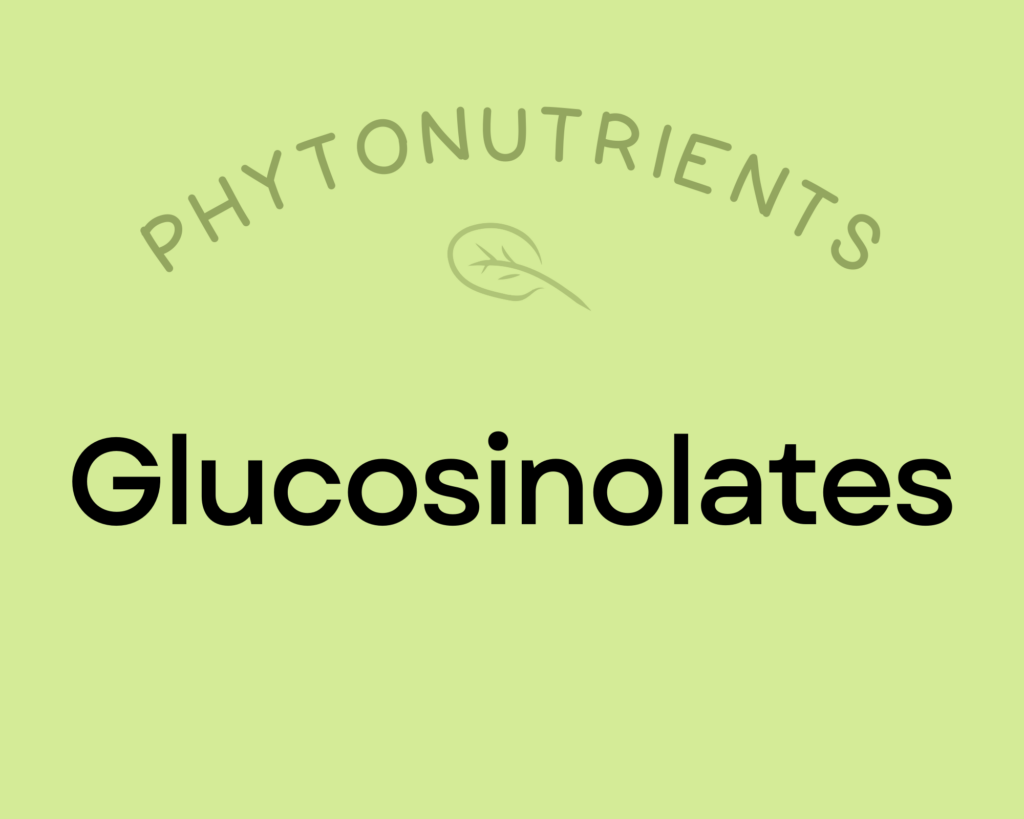
Glucosinolates are well-studied sulfur-containing compounds which break down into bioactive isothiocyanates and indoles when vegetables are damaged (via chewing, cutting, or other processing).
Isothiocyanates (like sulforaphane) are absolute rock stars as far as human health is concerned! Research spanning human epidemiology, animal models, and in vitro experiments show that dietary isothiocyanates are inversely associated with bladder cancer, lung cancer, colon cancer, breast cancer, and pancreatic cancer; some evidence also suggests they may be able to improve ventricular function following heart attacks.
Indoles also have powerful cancer prevention benefits through multiple mechanisms that include modulation of phases I and II detoxification enzymes, regulation of cell cycle arrest, control of cell growth, induction of apoptosis, antioxidant activity, anti-angiogenic effects, and epigenetic regulation. Indole-3-carbinol breaks down into 3,3′-Diindolylmethane (DIM), which is known for its anti-inflammatory, immune system modulating, cancer prevention and estrogen metabolism benefits.
Learn more about glucosinolates here.
Kale Provides 162% DV Vitamin K
Kale is a particularly awesome source of vitamin K, providing an impressive 162% of the daily value per 2-cup serving!
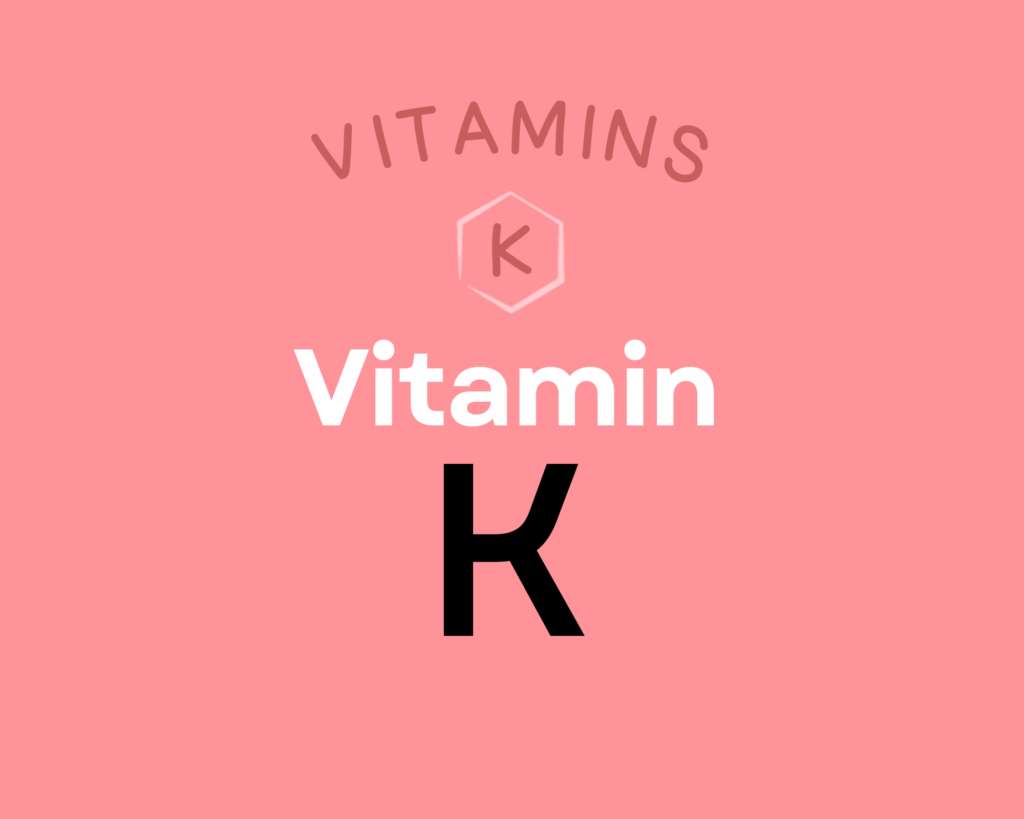
Vitamin K is actually a group of fat-soluble vitamins with a similar molecular structure, existing as K1, multiple isoforms of K2, and the synthetic form K3. This nutrient plays a vital role in coagulation, due to serving as a cofactor for proteins needed for blood clotting; it’s also essential for bone metabolism, cellular function, and the prevention of soft tissue calcification. Getting enough vitamin K2 can help protect against cardiovascular disease, may improve bone mineral density and skeletal health, and may even support endocrine function and brain health; there’s also some limited evidence it has anti-cancer and anti-inflammatory properties. Learn more about vitamin K here.
Kale Provides 60% DV Vitamin B7 (Biotin)
Kale is also an amazing source of vitamin B7 (biotin), providing 60% of the daily value per 2-cup serving!
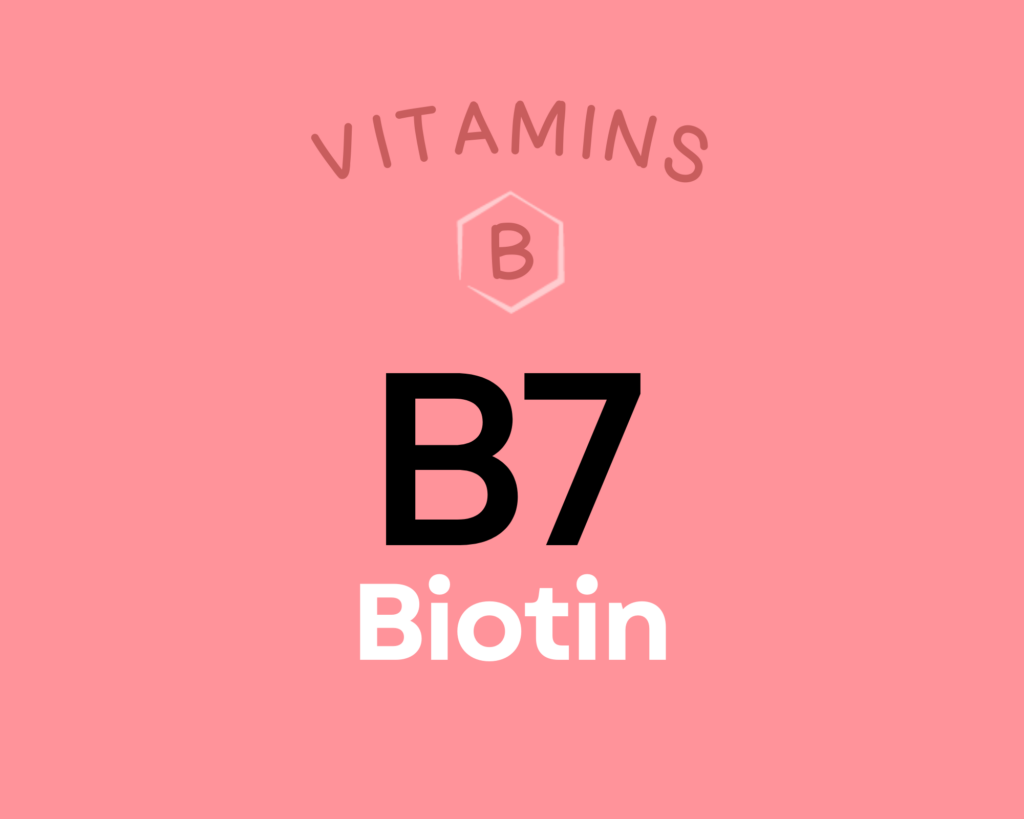
Biotin is a water-soluble B vitamin, also known as vitamin B7. Like other B vitamins, it plays an important role in energy metabolism (serving as a coenzyme for five carboxylase enzymes), neurotransmitter production, cellular function, and the function of various organs. Getting enough biotin can help support healthy nail and hair growth. It’s also particularly important during pregnancy, with low intakes increasing the risk of premature delivery and birth defects. There’s even some evidence biotin can benefit diabetics and reduce functional disabilities in people with multiple sclerosis. Learn more about biotin here.
Kale Provides 54% DV Vitamin C
This veggie is also an amazing source of vitamin C, providing 54% of the daily value per 2-cup serving!
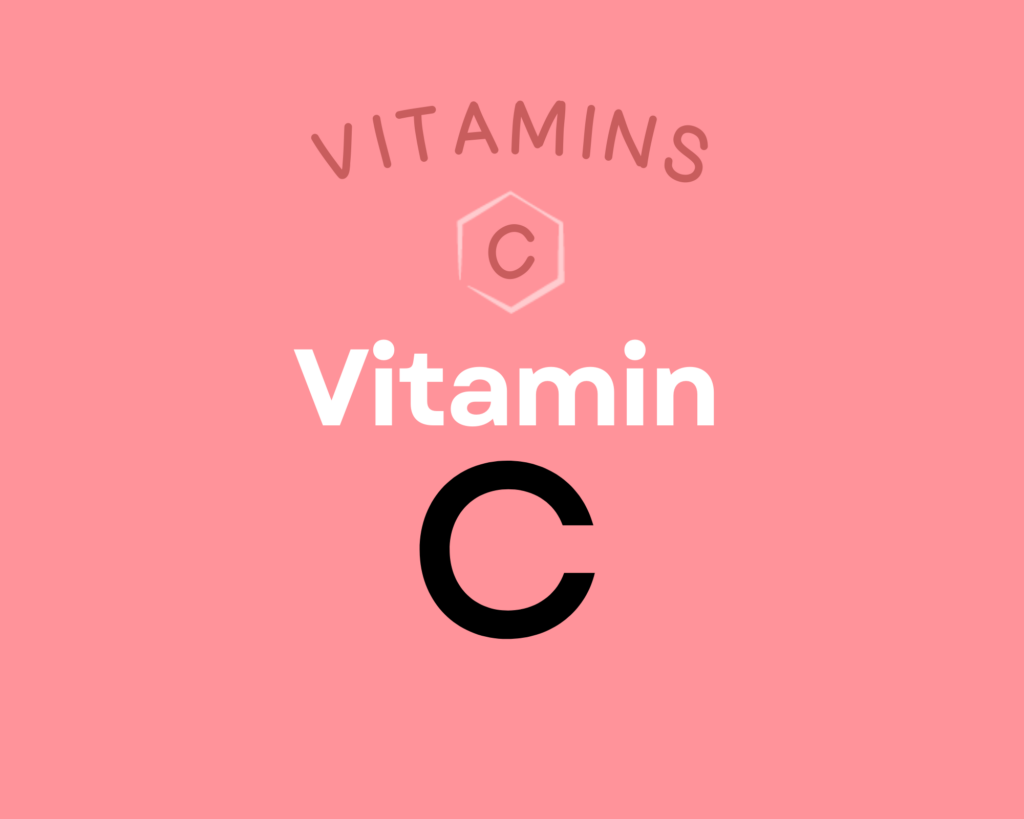
Vitamin C is a water-soluble vitamin that has powerful antioxidant properties (meaning it can help combat oxidative damage from free radicals and reactive oxygen species) and that serves as an enzyme cofactor (meaning it’s needed for enzymes to do their job, for example vitamin C is necessary for collagen synthesis, which is essential for bones, joints, teeth, blood vessels, skin and eyes) and playing important roles in immune system and skin health. Higher intakes of vitamin C are linked to reduced risk of heart disease, some forms of cancer, type 2 diabetes, cataracts, age-related macular degeneration, and gout. Vitamin C can also help regulate the stress response and reduce anxiety, and there’s preliminary evidence that it may also help prevent Alzheimer’s disease. Learn more about vitamin C here.
Kale Provides 4580.5 μg of Carotenoids
In addition, kale is an awesome source of carotenoids , providing 4580.5 μg of carotenoids per 2-cup serving!
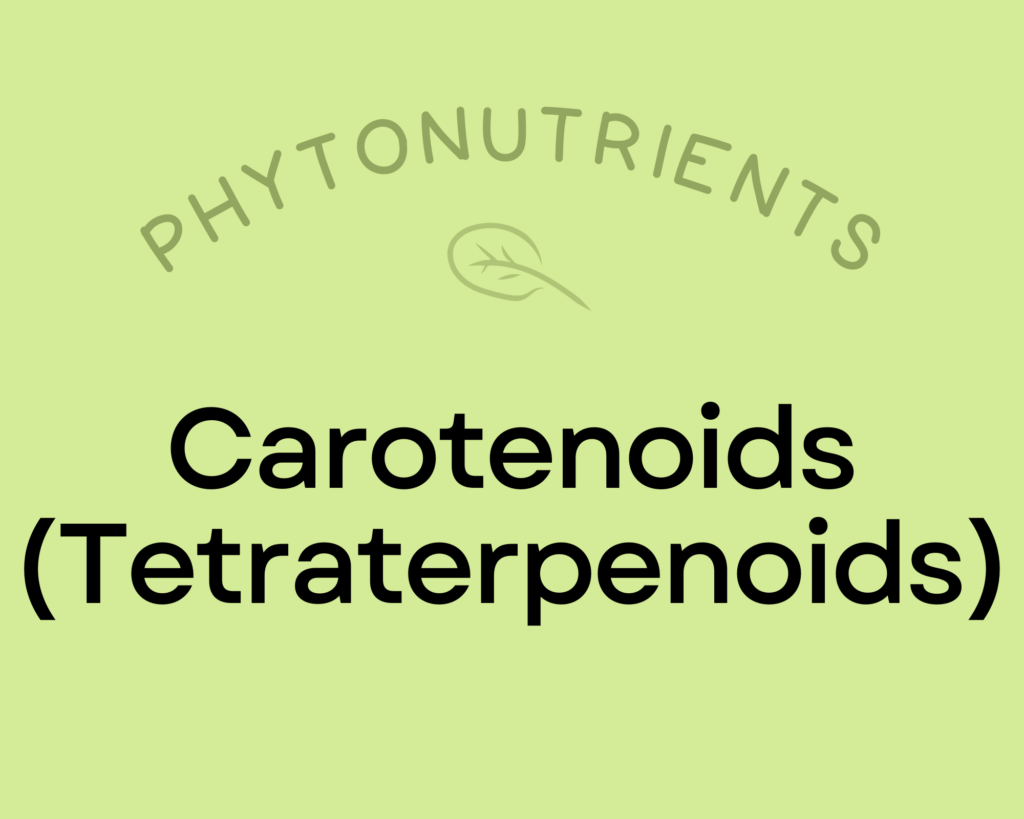
Carotenoids are a diverse group of phytonutrients that are responsible for giving fruits and vegetables vibrant red, orange, and yellow pigmentation. They were one of the earliest phytonutrients ever investigated by scientists (with research dating back to the 1800s!). Across studies, eating foods high in carotenoids appears to reduce the risk of head and neck cancers, supports vision health (particularly age-related eye diseases), may protect against metabolic syndrome and diabetes, and can reduce inflammation. Carotenoids have strong antioxidant properties, and help facilitate communication between cells by promoting the synthesis of connexin proteins, which create gap junctions in cell membranes that allow small molecules to be exchanged (which is part of how cells “talk” to each other!). Consuming carotenoids with fat significantly increases their absorption. Learn more about carotenoids here.
Kale Provides 177.5 mg of Polyphenols
Kale is an excellent source of polyphenols, providing 177.5 mg of polyphenols per 2-cup serving!
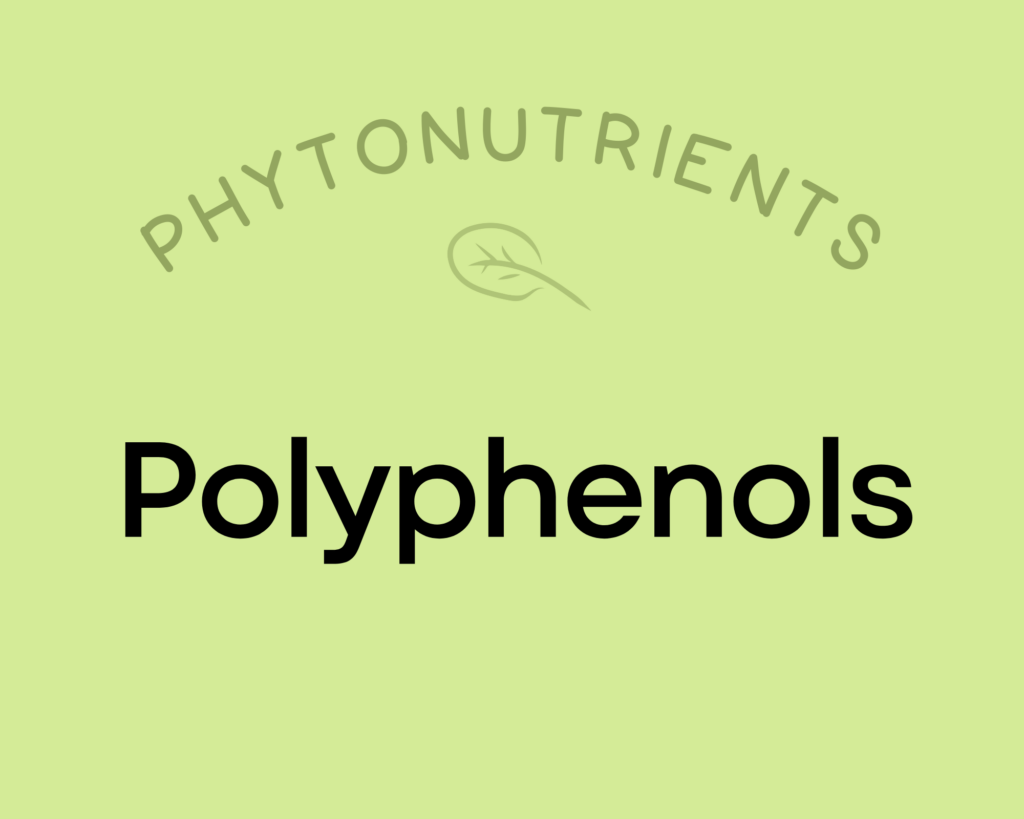
Polyphenols play a huge role in protecting against cancer, heart disease, diabetes, asthma, osteoporosis, neurodegenerative diseases, and other conditions associated with oxidative stress. In fact, a major reason foods like red wine and olive oil (as well as diets rich in both, such as the Mediterranean diet) show up as so beneficial may be due to their high polyphenol content! Along with chronic diseases, supplementing with polyphenols has been shown to protect against infections and reduce the signs of aging. Polyphenols exert their most potent effects by acting as antioxidants—preventing cellular damage by neutralizing hazardous oxygen radicals and improving cellular health as a result (which, in turn, benefits virtually every system in the body). As a result of their antioxidant properties, polyphenols also boost the immune system and protect against both chronic and acute diseases. In addition, polyphenols can help regulate enzyme function, stimulate cell receptors, modulate the functions of inflammatory cells (including T and B lymphocytes, macrophages, platelets, and natural killer cells), alter adhesion molecule expression, affect nerve cells and cardiac muscle cells, and exert antiviral effects. Learn more about polyphenols here.
Kale Provides 20% DV Manganese
This crucifer is also an excellent source of manganese, providing 20% of the daily value per 2-cup serving!
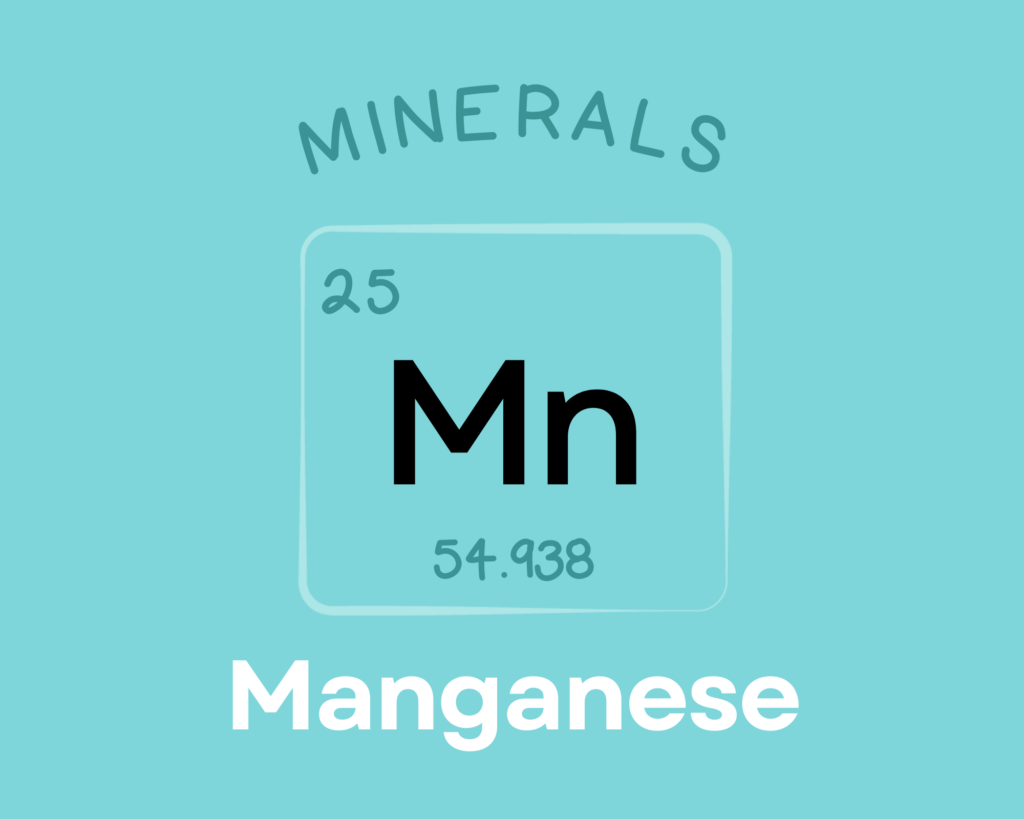
Manganese is an essential mineral that serves as a cofactor and component of numerous enzymes. Through these roles, it’s involved in carbohydrate metabolism, amino acid synthesis, gluconeogenesis, detoxification, lipid processing, free radical defense, bone and collagen formation, and wound healing. Although the research so far is limited, some evidence suggests that manganese can protect against osteoporosis and diabetes, and may even be involved in seizure disorders. Learn more about manganese here.
Learn What Foods Are the Best Sources of Every Nutrient

The Top 25 Foods for Every Nutrient
The Top 25 Foods for Every Nutrient e-book is a well-organized, easy-to-use, grocery store-friendly guide to help you choose foods that fit your needs of 43 important nutrients while creating a balanced nutrient-dense diet.
Get two “Top 25” food lists for each nutrient, plus you’ll find RDA charts for everyone, informative visuals, fun facts, serving sizes and the 58 foods that are Nutrient Super Stars!
Buy now for instant digital access.
How Much Kale Should We Eat Per Day?
You know the old aphorism, a Brassica vegetable a day keeps the doctor away! Wait, that’s not how it goes? It should be!
Every serving of fresh, whole vegetables or fruit we eat daily reduces the risk of all-cause mortality by 5% to 8%, with the greatest risk reduction seen when we consume five or more servings per day. In fact, consuming 800 grams of vegetables and fruits daily reduces all-cause mortality by 31% compared to eating less than 40 grams daily. A 2017 meta-analysis showed that 2.24 million deaths from cardiovascular disease, 660,000 deaths from cancer, and 7.8 million deaths from all causes could be avoided globally each year if everyone consumed 800 grams of veggies and fruits every day.
Eating vegetables and fruit in abundance lowers risk of cancer, cardiovascular disease, type 2 diabetes, obesity, chronic kidney disease, osteoporosis and bone fragility fractures (including hip fracture), cognitive impairment and dementia (including Alzheimer’s disease), neurodegenerative diseases, asthma, allergies, chronic obstructive pulmonary disease, age-related macular degeneration, cataracts, glaucoma, depression, ulcerative colitis and Crohn’s disease, rheumatoid arthritis, inflammatory polyarthritis, non-alcoholic fatty liver disease, acne, seborrheic dermatitis, and lowers markers of inflammation. Learn more in Importance of Vegetables and Fruit.
Covering half of your plate with a variety of vegetables (and three quarters of your plate if your starchy food is a root vegetable or winter squash) at each meal is a simple way to easily achieve the goal of 5 or more servings of vegetables daily.
Studies show that, for every 100 grams of cruciferous veggies (like kale), we eat daily, all-cause mortality decreases by 24%!
One to two servings per day of leafy greens is a great target, but there doesn’t seem to be any downside to consuming way more than that!
Studies also show that leafy greens (like kale) offer a huge range of scientifically demonstrated health benefits. For instance, for every 1/3 cup of leafy greens you eat each day you reduce the risk of type 2 diabetes by 13%. Leafy green consumption has also been associated with a 40% lower risk of death from colorectal cancer in men, a 16% reduction in cardiovascular disease and slower cognitive decline in elderly adults. Amazingly, an average of only 1.3 servings per day was associated with the equivalent of being 11 years younger in cognitive age! Taking this all into account means that one to two servings per day of leafy greens (like kale) is a great target, but there doesn’t seem to be any downside to consuming way more than that!
Just remember, it’s always best to mix up the veggies you eat day to day (aiming for a wide variety of different vegetables and fruits throughout the week), and kale definitely has a place at the table.
The Best Support to Build This Important Daily Habit!
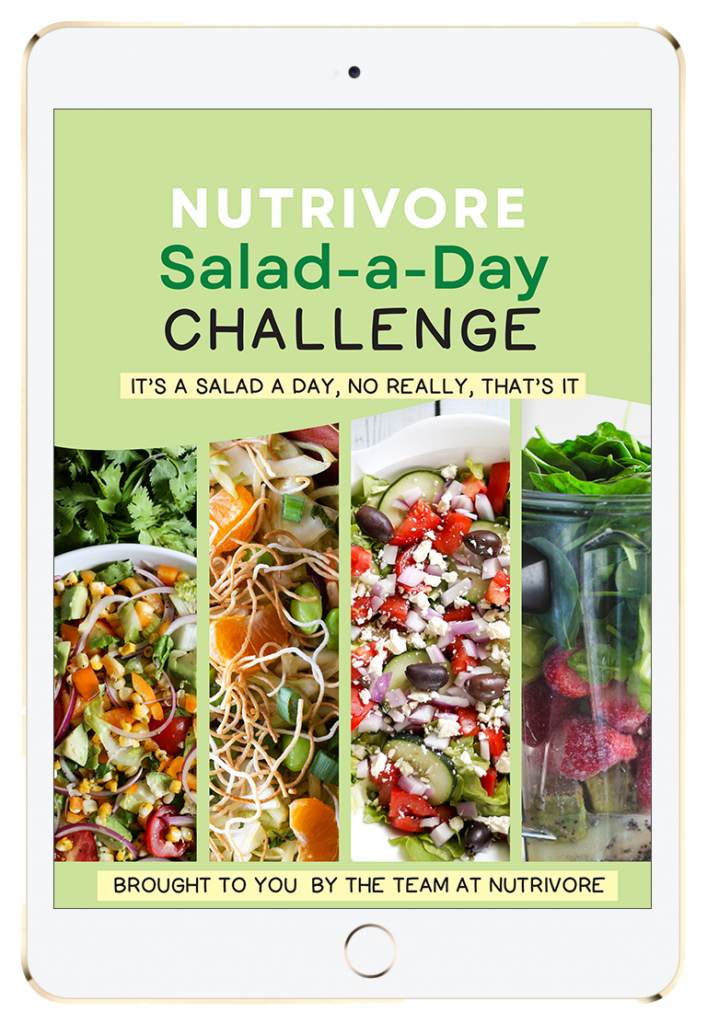
Nutrivore Salad-a-Day Challenge
The Nutrivore Salad-a-Day Challenge e-book explains all the ways a daily salad can improve your health, plus includes a collection of 10 handy visual guides and food lists, like the Nutrivore Salad Matrix.
Plus, you’ll find 50+ recipes, including over 30 of our favorite salad recipes plus recipes for delicious dressings and tasty toppers.
Buy now for instant digital access.
Citations
Expand to see all scientific references for this article.
Fineli Finnish Food Composition Database: Kale
Halliwell B, Cheah IK, Tang RMY. Ergothioneine – a diet-derived antioxidant with therapeutic potential. FEBS Lett. 2018 Oct;592(20):3357-3366. doi: 10.1002/1873-3468.13123. Epub 2018 Jun 15. PMID: 29851075.
Korus A. Level of Vitamin C, Polyphenols, and Antioxidant and Enzymatic Activity in Three Varieties of Kale (BrassicaOleracea L. Var. Acephala) at Different Stages of Maturity. International Journal of Food Properties. 2011. 14(5):1069-1080. doi: 10.1080/10942910903580926
McNaughton SA, Marks GC. Development of a food composition database for the estimation of dietary intakes of glucosinolates, the biologically active constituents of cruciferous vegetables. Br J Nutr. 2003 Sep;90(3):687-97. doi: 10.1079/bjn2003917. PMID: 13129476.
USDA Food Central Database: Kale, raw
Watanabe T, Kioka M, Fukushima A, Morimoto M, Sawamura H. Biotin content table of select foods and biotin intake in Japanese. Int J Anal Bio-Sci. 2014. Vol 2(4):109-125.


